The Meizu PRO 5 Review
by Matt Humrick on June 24, 2016 8:00 AM EST- Posted in
- Smartphones
- Exynos
- Mobile
- Meizu
- Exynos 7420
GPU Performance
Meizu’s PRO 5 uses a Mali-T760MP8 GPU with a maximum frequency of 772MHz for ALU-heavy workloads. Based on ARM’s Midgard architecture, the Mali-T760 is capable of outperforming Qualcomm’s previous generation Adreno 400 series GPUs at vertex processing, but falls behind in pixel processing.

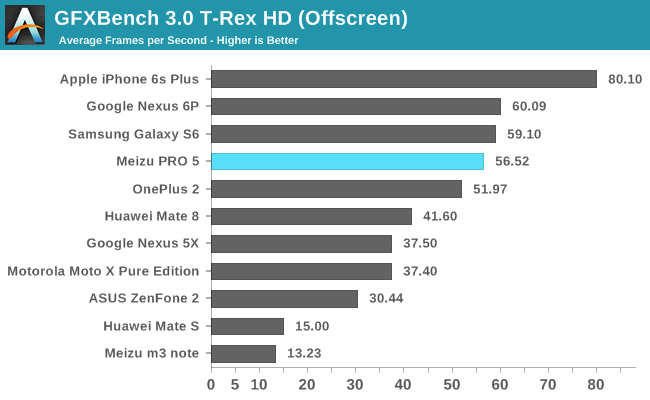
To better understand how the PRO 5 performs across a wide variety of games, we will start by looking at the OpenGL ES 2.0-based T-Rex game simulation. Because of its 1080p display, it has fewer pixels to process than the 1440p Galaxy S6, leading to better onscreen performance. Peak offscreen performance is also good, comparable to the Nexus 6P and its Adreno 430 GPU.
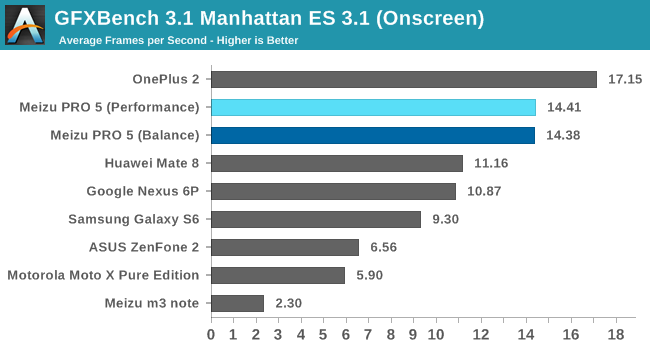
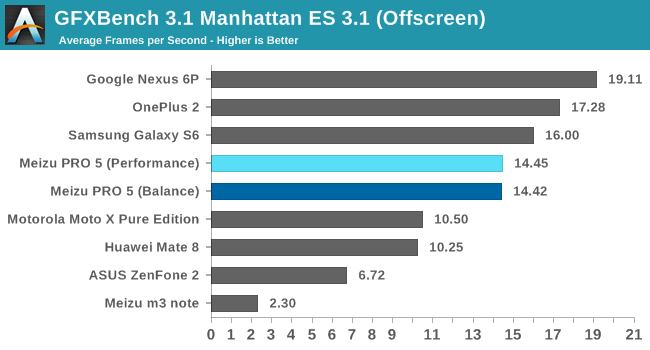
The GFXBench 4.0 Car Chase game simulation, which uses OpenGL ES 3.1 plus Android Extension Pack (AEP) features, is part of our normal test suite; however, the PRO 5 does not support hardware tessellation and is not able to run this test, so instead we’ll fall back to using GFXBench Manhattan 3.1, which still uses OpenGL ES 3.1 but does not use any AEP features.
Starting off, the PRO 5’s results are the same for both the Performance and Balance power modes. While the different modes will have some effect on performance for games that are more CPU bound, this test is entirely GPU limited, and because the PRO 5’s power modes do not affect GPU frequency, they have no impact in this test.
In the offscreen test, the PRO 5 is about 38% faster than the Moto X Pure Edition (Adreno 418) and the Mate 8, which uses the newer Mali-T880 GPU. While the Mali-T880 includes three ALU units per core versus two ALUs per core for the Mali-T760, the Mate 8 uses only four cores where the PRO 5 uses eight. After accounting for the difference in GPU clock frequency, this gives the PRO 5 124 GFLOPS of FP32 throughput versus 108 GFLOPS for the Mate 8. And because the PRO 5 has twice as many cores as the Mate 8, it can process twice as many texels/pixels per cycle too. This also applies to Huawei’s P9, whose Kirin 955 SoC uses the same Mali-T880MP4 GPU.
In the older GFXBench T-Rex test, the PRO 5’s performance was similar to the OnePlus 2 and Nexus 6P, which both use Qualcomm’s previous generation Adreno 430 GPU. This test, however, includes many more pixel effects, which take advantage of Adreno’s superior ALU performance, giving the Nexus 6P a 32% advantage over the PRO 5. While not shown in the charts above, phones such as the LG G5, which use the latest Snapdragon 820 SoC and its Adreno 530 GPU, are about twice as fast as the PRO 5 in this test.
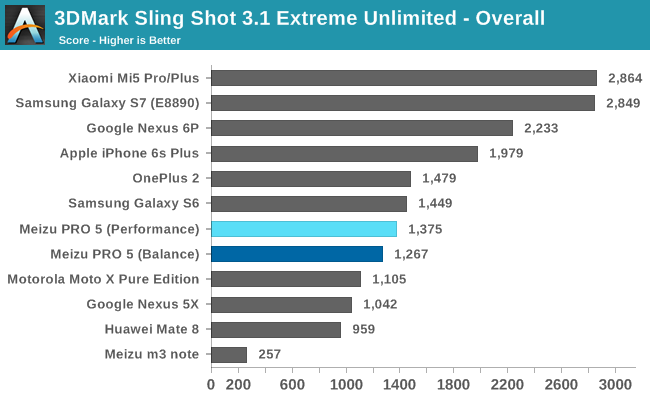
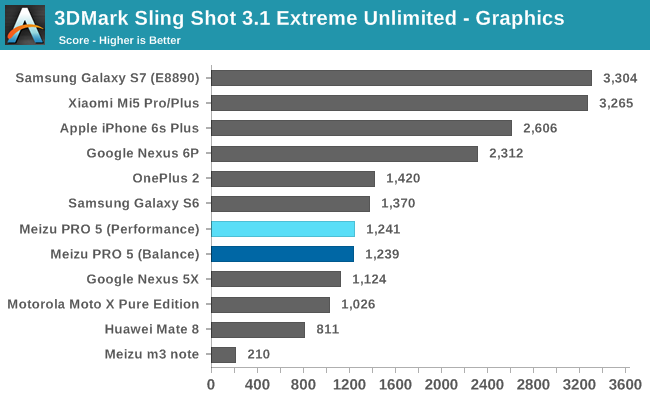
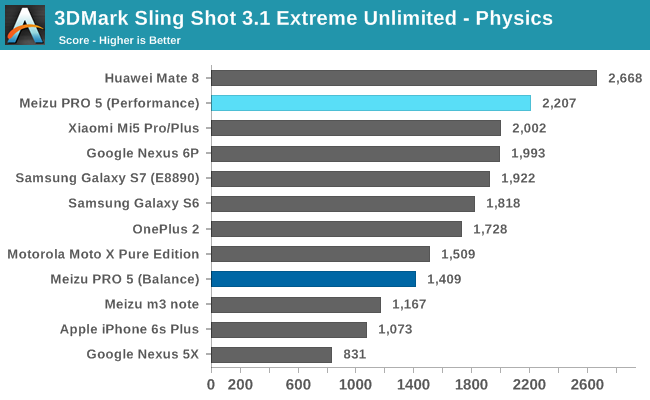
3DMark Sling Shot Extreme is another OpenGL ES 3.1 game simulation test that renders offscreen at a higher 1440p resolution than our other tests (the Physics test renders at 720p) and includes both GPU and CPU elements. Zeroing in on the graphics score, we see the PRO 5 outperform the phones using Adreno 418 and Mali-T880MP4 GPUs once again. The Nexus 6P and its Adreno 430 is 86% faster, however. The Xiaomi Mi5 (Adreno 530) and Galaxy S7 (Mali-T880MP12) perform about the same in this test with peak performance 2.66x higher than the PRO 5.
The Physics test measures CPU and memory performance by running an open source physics simulator. The PRO 5 and its Exynos 7420 SoC perform quite well, outperforming the newer Exynos 8890 and Snapdragon 820 SoCs in the Galaxy S7 and Xiaomi Mi5, respectively. Only the Mate 8’s Kirin 950 performs better. Because this is primarily a CPU test, we see a significant difference in performance between the PRO 5’s Performance and Balance modes, with the former showing a 57% advantage.
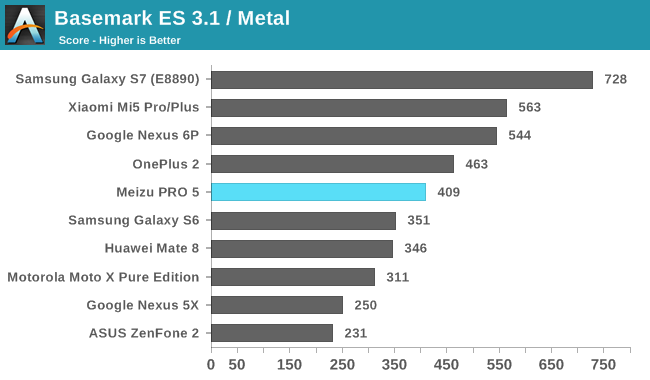
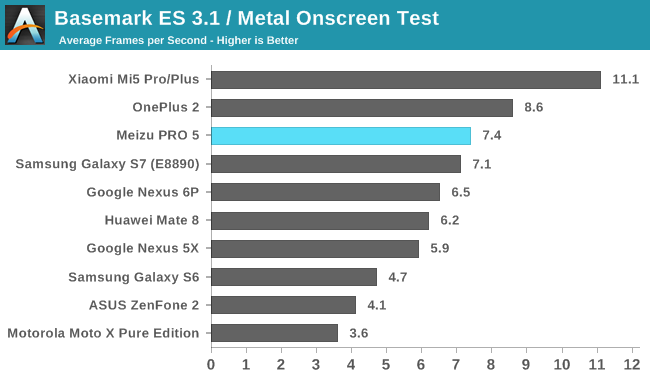
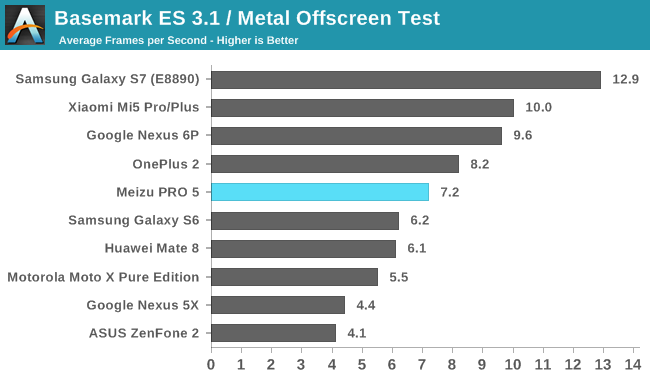
The previous performance trends hold true in Basemark ES 3.1. The Galaxy S7 at the top of the offscreen chart uses a Mali-T880MP12 GPU running at up to 650MHz. This gives it a peak, theoretical FP32 throughput of 234 GFLOPS, more than twice the Mate 8’s 108 GFLOPS and about 1.9x the PRO 5’s 124 GFLOPS, which is very close to the overall performance difference between the PRO 5 and Galaxy S7 (Exynos 8890).
The Meizu PRO 5 is certainly capable of playing modern games as long as they do not require hardware tessellation—its graphics driver currently does not support this feature. It cannot match the peak performance of the latest SoCs, but that level of performance is still overkill for the majority of games currently available. Its 1080p display, which is a negative mark overall, at least helps improve onscreen graphics performance.










80 Comments
View All Comments
Impulses - Friday, June 24, 2016 - link
Yup, personally I don't care much for these reviews (unless the devices are more readily available in the USA) but I don't mind them either (the audio part here was very interesting!) AND I DO remember reading requests for Meizu/Xiaomi/etc reviews for a long long time in the comments section of older reviews... I've no doubt Andrei is right as far as the existing demand for this content.jimbo2779 - Friday, June 24, 2016 - link
I think it's great to see brands that are not just us centric.aryonoco - Friday, June 24, 2016 - link
Thanks Andrei.I have no problems with phones targeting different markets being reviewed. In fact as someone from Australia, I like that AT seems to be less NA focused recently.
Can I just ask that reviews list the LTE bands supported clearly in the spec table? It really is as important as storage or camera spec, at least. I know which bands my carrier uses, so if the LTE bands are listed, I'd know if the phone is useful for me or not. Sometimes finding exactly the LTE bands that some of these Chinese phones support is not at all east.
asfletch - Monday, June 27, 2016 - link
At least most Chinese phones support band 3, which is common to all the major carriers here in Australia. Makes them much more attractive for us than for US buyers. Many also support Band 40, which is used by Optus. Support for Bands 5 and 28 is rare though, so we tend not to get the fastest available service on Chinese handsets.LiverpoolFC5903 - Tuesday, July 5, 2016 - link
Thank you!The likes of Meizu, Xiaomi,Oppo, Vivo, Huawei, ZTE, One plus and others have a lot of good stuff to offer and at mostly great prices.
Keep doing what you are doing, love the content on here.
andychow - Sunday, June 26, 2016 - link
I agree with you %100. Anandtech doesn't review %20 of available phones, why would they review phones incompatible with North American LTE? Cover us first, then cover the in-compatible phones with a big warning. America comes first. That's the truth.more-or-less - Friday, June 24, 2016 - link
BTW to all AT editors, can you include comments using Facebook/Twitter/Google/Disqus etc., I have been reading for years, yet never wanted to create a seperate account for commenting.Impulses - Friday, June 24, 2016 - link
Disqus is annoying AF... IMO Only good part about it are email notifications, but it loads slow and doesn't look that great.Eden-K121D - Friday, June 24, 2016 - link
AnandTech is too goddamn lazy and lethargic to bring the S7 review part 2 or HTC 10 review or GTX 1080/70 reviwGeranium - Friday, June 24, 2016 - link
@AnandTech,Why you guys are putting Android benchmark and iOS benchmark in same chart? Aren't those different platform?